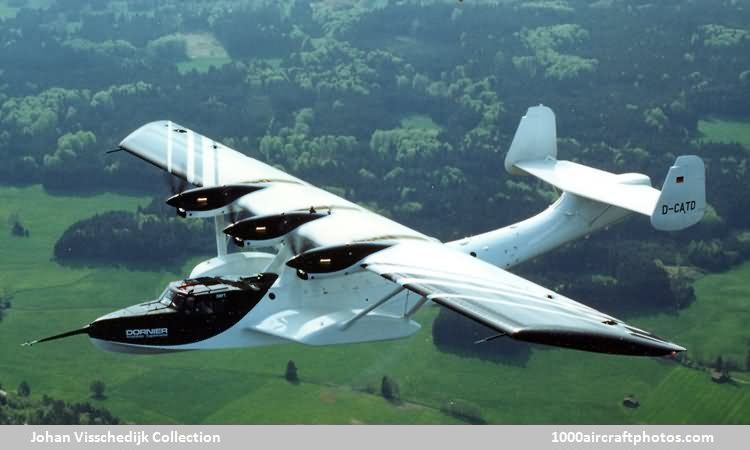Funded by the Bundesministerium für Forschung und Technologie (Federal German Ministry of Research and Technology), a program was subsequently set up to study by flight tests the effect of new technologies on the seaworthiness, operational flexibility, performance and economy of an advanced amphibian flying boat. Initially known as the Do 24 TT, later as the Do ATT (Amphibien-Technologieträger, Amphibian Technology Test bed), this project entered the definition phase in April 1979. This was completed in June 1980, and was followed by a construction and test phase. A former Spanish AF Do 24 T became the experimental test bed, it retained the hull and tail surfaces of that aircraft, but was fitted with an entirely new wing; new engines; new sponsons; an elevated flight deck roof, as well as a landing gear.
The new technology wing, unlike the right-angled trapezoidal wing on the TNT test bed aircraft, had a rectangular planform from the root to the beginning of the wing tip, and a Do A-5 airfoil section throughout. Compared with conventional airfoils, this wing had reduced drag and increased lift. Its triangular tip also produced a reduction in induced drag by comparison with a conventional wing tip. Three 1,125 shp Pratt & Whitney Canada PT6A-45B turboprop engines, each driving a Hartzell HCB5-MP-3 five-blade variable-pitch propeller, replaced the original piston radials. For full amphibious capability a retractable tricycle landing gear was installed, comprising two Dornier Do 31 twin-wheel main landing gear units and a Fokker F-27 single-wheel nose unit.
Under a restriction of 150 flying hours the Do 24 ATT was registered D-CATD in March 1983. With Dornier's Chief Test Pilot Dieter Thomas and co-pilot Meinhard Feuersenger at the controls it was first flown at the Oberpfaffenhofen company airfield on April 25, 1983. The experimental amphibian was tested in detail for over a year and included landing tests on land, inland waters and high seas, as well as taxi and maneuvering trials on the water and beaching by using a slip ramp. The first water trials were conducted at the West German naval air station at Kiel-Holtenau in August 1983. However, in 1984 the flying hours had been used up, while in 1985 Dornier became a subsidiary of Daimler-Benz and a change in company strategy subsequently ended the program. The aircraft was donated to the Deutsches Museum Flugwerft Schleißheim, near Munich.
In 2003, Iren Dornier, grandson of the famous Claude Dornier, purchased the aircraft and shipped it to the Philippines where it was overhauled, whereafter it received a Philippine CofA. Registered RP-C2403 Iren Dornier used the aircraft (nicknamed "Latina") for Mission Dream, a world tour promoting and collecting for UNICEF. The tour started in the Philippines in April 2004 and the aircraft visited some ninety destinations in more than 30 countries, ending in Germany in early 2005. In 2006 the aircraft was based at Oberpfaffenhofen, near Munich, Germany, touring Europe for air shows and promotional flights. When the Philippine permit expired the aircraft was grounded and stored at Oberpfaffenhofen.
In early 2010 another overhaul was initiated, this time to gain a German CofA, that was issued on October 19, 2011, the new registration was D-CIDO. Again the aircraft participated in air shows and made promotional flights. During the 2015 Scalaria Air Challenge at the Wolfgangsee (Lake Wolfgang) in Austria, pilot Iren Dornier initiated a planned tough-and-go. After gently settling on the water, the aircraft hit a submerged tree trunk which punctured the hull and after a spectacular 270° swerve the aircraft came to a sudden stop, the cabin flooded some 20 in (50 cm) high. By December 2015 the hole had been repaired, but the repairs of water-damaged electronics are still in progress. It is planned to have the aircraft back in the air by the end of the year."
